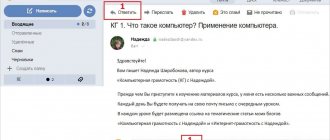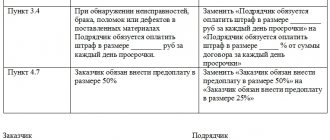FREE CONSULTATION WITH A LAWYER
Tel.
+7 (800) 302-65-54 Free in Russia
If an official of the inspection organization (sanitary inspection, fire inspection and many others) discovered irregularities in the work of the enterprise, the manager or other authorized person must draw up a comprehensive response in writing within the time period specified in the order itself. A sample response to an order to eliminate violations, ready-made examples and recommendations for its preparation can be found below.
Expert opinion
Sobolev Dmitry
Administrative offenses lawyer, website expert
Previously, we provided a sample response to tax requirements; we advise you to also read this information at this link.
Measures to eliminate the violation
When you receive an order, you must carefully study it and outline an action plan to correct the violation. The response itself must be provided only after the relevant measures have actually been carried out (no later than the deadline specified in the administrative document). These measures include:
- Development of various documentation - orders, contracts, agreements, safety instructions, manuals for workers and many others.
- Conducting training events – for example, on safety precautions.
- Re-equipment of premises, vehicles, engineering systems - for example, installing a means of monitoring the presence of a car on the line. Financial documents are provided confirming the purchase of equipment, furniture, etc.
- Sending explanations in connection with the elimination of the violation to all divisions of the company, branches and representative offices (confirmed by relevant letters, orders and other documents).
- Disciplinary sanctions against employees - this can be a reprimand, a reprimand, or even dismissal for appropriate reasons.
A response to a proposal to eliminate identified violations is drawn up only if the enterprise agrees with the position of the inspector. If there is disagreement, this can also be indicated in the letter. However, it is more important to first draw up a statement of appeal addressed to management or a claim to a judicial authority.
Generating a response
If the violator does not agree with the requirements, he can express his objection in the form of a claim, which is recorded by the inspector. Such an objection must be substantiated using documentation, independent examinations and other reliable evidence.
Although the law does not establish the need to send a report on the results of measures taken to eliminate violations identified by the inspection, it is recommended to submit this document to the supervisory authority.
In it, the violator indicates in detail how exactly the order was carried out (attention should be paid to each stage), and also supports, for example, certificates or examination data. As a rule, the more evidence the violator provides, the less likely it is that the case will go to trial.
This is important to know: Power of attorney to receive goods and material assets: how to draw up correctly, form and sample for 2021
The expiration of the established period entails an extraordinary inspection. Data on the absence of violations is documented.
The document is drawn up in two copies, signed by the violator who fulfilled the order, and by the controlling body or person. A copy of the inspection report is provided to both parties.
However, it is noted that in practice, inspectors carry out inspections only on the basis of the report on elimination of violations provided by the violator. If there is no such act, the supervisory authority refers the case to the court. This explains the importance of sending a report on the execution of the order to the regulatory authority.
Sample response to an order to eliminate violations
There are no strict requirements for the sample response to instructions, so the company has the right to compose it in any form in compliance with the standard structure for such documents. The answer is drawn up on A4 sheets or on the organization’s letterhead. The text must reflect the following information:
- The name of the department, full name, position of its head or other employee in whose name the response was drawn up.
- Name of the organization, full name, position of the director sending the letter.
- Address, details and contact details of the company.
- Registration mark in the journal of outgoing correspondence (document number and date of sending).
- Title: “Response to the order to eliminate violations” indicating the number of this order and the date of its preparation.
- The actual text of the document contains a description of the specific measures that were taken to fulfill the requirements of the inspector or other official. Can be presented in the form of a list, table or other convenient way.
- Appendixes – a list of documents that confirm the fact of the measures taken.
- Date, full name, signature of the director, seal of the organization.
A sample of a real response to an order looks like this.
You can also create a document in the form of a table. The columns list the sequence of activities carried out, the requirements of the regulations that they fulfill, as well as specific content with references to the documents drawn up (orders, instructions, etc.).

The employer's obligation to comply with the order
Like regulations, a document drawn up by a labor protection specialist (service) is mandatory. In fact, this is not a proposal, but a demand to eliminate certain violations. Accordingly, the employer is obliged to take action, otherwise he may be held liable.
A labor protection specialist has the right to issue orders regarding violations of labor protection rules in an organization. The storage period for prescriptions is five years. They are recorded according to the rules defined by the organization in local regulations. Rationale:
Article 10 of the Federal Law of February 23, 2013 N 15-FZ “On protecting the health of citizens from the effects of second hand tobacco smoke and the consequences of tobacco consumption” defines the rights and obligations of the employer in the field of protecting the health of citizens from the effects of second hand tobacco smoke and the consequences of tobacco consumption. Thus, employers are obliged to monitor compliance with legislation in the field of protecting the health of citizens from the effects of environmental tobacco smoke and the consequences of tobacco consumption in the territories and premises used for their activities, as well as to ensure the rights of employees to a favorable living environment. In addition, employers have the right to establish a ban on tobacco smoking in the territories and premises used to carry out their activities, as well as, in compliance with the Labor Code of the Russian Federation, to apply incentive measures aimed at stopping tobacco consumption by employees. If the employer has established smoking rules on the territory of the organization (for example, prohibited smoking altogether or created special places for this), they must be enshrined in the local regulations of the organization. At the same time, employees must be familiar with such rules upon signature. Based on Art. 217 of the Labor Code of the Russian Federation, in order to ensure compliance with labor protection requirements and monitor their implementation, each employer engaged in production activities, whose number of employees exceeds 50 people, creates a labor protection service or introduces the position of a labor protection specialist with appropriate training or experience in this area. Moreover, if the number of employees is less than 50 people, the decision to create a labor protection service or introduce the position of a labor protection specialist is made taking into account the specifics of its production activities. The structure of the labor protection service in an organization and the number of employees are determined taking into account the Recommendations for organizing the work of the labor protection service in an organization, approved by Resolution of the Ministry of Labor of Russia dated 02/08/2000 N 14 (hereinafter referred to as the Recommendations). These Recommendations also specify the functions and rights of the service. So, according to paragraphs. 8.2 Recommendations Labor protection service employees have the right to present to heads of departments and other officials of the organization mandatory instructions to eliminate violations of labor protection requirements identified during inspections and to monitor their implementation. There are no specific recommendations for organizing the work of a labor protection specialist, but we believe that the Recommendations can be used and the duty to issue instructions to violators of labor protection rules can be established in a job description or employment contract. Accordingly, if the smoking rules on the territory of the organization are enshrined in a local act, and the employee violates them, the occupational safety specialist has the right to issue an order to eliminate violations of occupational safety requirements. The records of the instructions issued by the occupational safety specialist are kept according to the rules established by the employer's local regulations (for example, this may be a logbook). The storage period for instructions in the organization is five years. At the same time, it is necessary to store so much not only the instructions themselves, but also the logs of such records (List of standard administrative archival documents generated in the process of activities of state bodies, local governments and organizations, indicating storage periods, approved by Order of the Ministry of Culture of Russia dated August 25, 2010 N 558 ).
Can an occupational safety specialist issue orders to employees regarding violation of occupational safety regulations in connection with smoking on the territory of the organization? How to keep records of such orders? What is the shelf life of prescriptions?
In accordance with labor laws, certain types of production activities must be carried out while ensuring the safety of employees. Depending on the specifics and severity of production, these standards change, but the only thing they have in common is that failure to use personal protective equipment is a gross violation of labor protection. Personal protective equipment must be mandatory:
- In hazardous industries. For this type of activity, there are a huge number of different standards that are related to ensuring the safety of workers, as well as work and rest standards. Here, personal protective equipment is used, developed depending on the specifics of this “harm”: radiation, dirty air, heavy metals, etc.
- Production facilities with high or low temperature conditions. Due to the specific nature of the activity, employees do not have the right to start work without PPE. The employer must comply with all requirements for monitoring the lawful performance of activities, provide personal protective equipment, etc.
- Activities that are accompanied by a high risk of injury. For this type, a whole system must be developed to minimize this risk, as well as mutual responsibility of both the employee and the employer. Some must be responsible for fulfilling their obligations within the framework of the developed system, others must ensure maximum safety for their employees through the provision of a functioning security system, as well as personal protection.
Important!
If personal protective equipment is missing or malfunctions for any reason, the employee does not have the right to perform his job duties. In this case, downtime in production must be paid by the employer as a working day, since responsibility for downtime falls entirely on the employer.
Is the manager required to write a response?
First of all, it is important to understand that the organization is not required to prepare a report (response) on the measures taken, since it is assumed that the inspection body can subsequently organize a new scheduled inspection. Its purpose is to ensure that the company has taken all necessary measures to eliminate the violation, i.e. At the time of the new inspection, the order must be fulfilled.
However, if the manager writes a response and lists the actions taken, a secondary review may not follow if the inspectors consider that the actions described in the document are sufficient. Another important point is that during a new visit to the company, inspectors may find other violations. If you compose and send a comprehensive response in a timely manner, such a risk is practically eliminated.
Thus, failure to respond does not constitute a violation, and no penalties are provided for this situation. However, it is in the company’s interests to respond to the order in writing and eliminate any violations found.
What it is
The legislation establishes that the authorized body responsible for checking the activities of an economic entity, if faults are detected, issues an order to the latter to eliminate the violations.
It expresses the requirement of the inspector and its execution is mandatory. But in itself it cannot entail the imposition of any sanctions.
At the same time, failure to comply within the prescribed period entails punishment under Art. 19.5 Code of Administrative Offenses of the Russian Federation.
The issuance of an order, as well as certain requirements for the information that must be contained in it, are regulated by the Federal Law of December 26, 2009 No. 294-FZ “On the protection of the rights of legal entities and individual entrepreneurs in the exercise of state control (supervision) and municipal control” (hereinafter referred to as text – Law).
Recommendations for drafting the document
The response is a progress report. It is drawn up on the basis of the regulation itself - a duplicate record of violated norms, links to relevant laws and other regulatory documents. The actions themselves must contain specific measures aimed at eliminating the violation.
In addition, the letter can indicate that the organization will take all possible measures to prevent the occurrence of such errors in work. The document is drawn up as briefly as possible in an official business style. All described actions must be supported by specific documentary evidence.
The document can be sent to:
- in person or by courier;
- by mail (by registered mail with written notification and a list of attachments);
- by email, if the inspection organization allows this possibility.
It is better to prepare a response in advance so that the deadlines for eliminating violations are not violated; otherwise, the organization may face an administrative fine.








